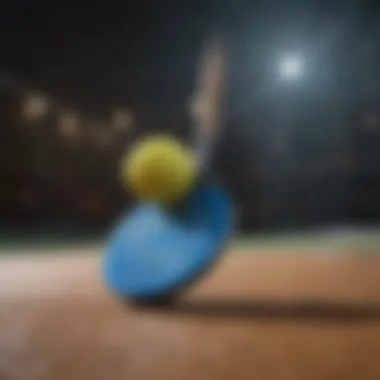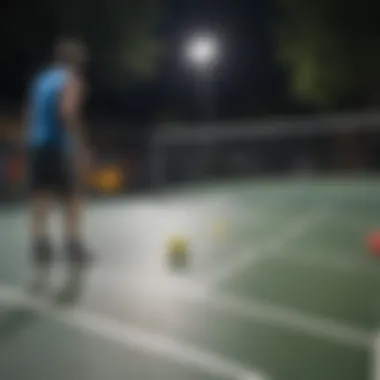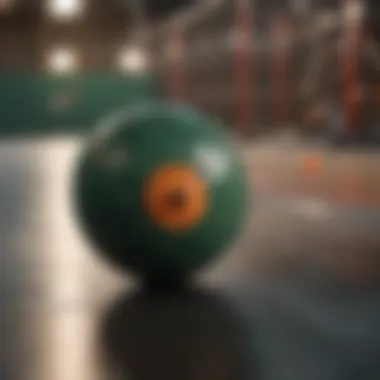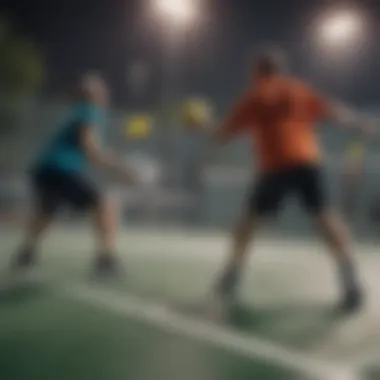Unraveling the Fascinating World of Pickleball: A Complete Guide for Enthusiasts


Wellness
Pickleball, a rapidly growing sport 🏓 that combines elements of tennis, badminton, and table tennis, is not only a form of physical exercise but also a mental stimulant, offering a unique blend of strategic thinking and agility. Playing pickleball regularly can significantly improve physical health by enhancing cardiovascular endurance, muscular strength, and balance. The fast-paced nature of the game boosts heart rate and burns calories, making it an excellent choice for individuals seeking a fun yet effective workout. Additionally, the hand-eye coordination, quick reflexes, and decision-making skills required in pickleball contribute to mental acuity and cognitive sharpness, promoting overall mental wellness.
Introduction to Pickleball
Pickleball has emerged as a dynamically popular sport that intrigues players of all ages and abilities. In this comprehensive guide, we will navigate through the multifaceted world of pickleball, dissecting its nuances and strategic elements that make it a compelling choice for sports enthusiasts. From its humble beginnings to its current status as a phenomenon in the realm of paddle sports, pickleball presents a unique blend of skill, strategy, and social engagement.
Defining Pickleball
Paddle Sport Origins
Exploring the roots of pickleball unveils a fascinating evolution from its inception as a backyard pastime to a structured competitive sport. The origins of pickleball trace back to the mid-1960s, where its founders sought to combine the elements of tennis, badminton, and table tennis into a cohesive and engaging activity. This amalgamation of different sports not only provided a fresh and dynamic gameplay experience but also facilitated the integration of diverse skill sets among players.
Combination of Tennis, Badminton, and Ping Pong
The fusion of tennis's strategic ball placement, badminton's swift court coverage, and ping pong's quick reflex demands creates a unique sporting experience. Pickleball's ability to draw elements from these established sports enhances its appeal to a wide range of enthusiasts looking for a challenging yet accessible activity. This combination not only diversifies the playing style but also adds layers of complexity that keep players constantly engaged and invested in honing their skills.
Court Dimensions and Equipment
The compact and standardized court dimensions of pickleball, coupled with the specialized equipment required, contribute to its fast-paced and exhilarating gameplay. With a court size one-third the dimensions of a tennis court and specific paddles designed for power and control, pickleball offers players a dynamic environment to showcase their agility and precision. Understanding the intricate relationship between court dimensions and equipment is fundamental to mastering the strategic and tactical aspects of the game.
Popularity Surge
Growth in Recent Years
Pickleball's surge in popularity in recent years reflects its inherent appeal and adaptability to the modern sporting landscape. As more players discover the joy of pickleball, the sport has witnessed exponential growth in participation rates and community engagements. The rise of pickleball as a mainstream recreational activity highlights its potential to become a staple in the sporting world, drawing enthusiasts from various age groups and skill levels.
Appeal to All Age Groups
One of the unique aspects of pickleball is its universal appeal across different age demographics. Whether you are a young athlete seeking a new challenge or a seasoned player looking for a low-impact yet engaging sport, pickleball caters to a diverse audience. The inclusive nature of pickleball in accommodating players of all ages fosters a vibrant and supportive community that celebrates skill development and camaraderie on and off the court.
Community and Social Aspects
Beyond its competitive allure, pickleball thrives on its community and social dimensions that promote interaction, collaboration, and personal growth. Joining a pickleball community not only offers players the opportunity to engage in friendly matches and competitions but also fosters lasting friendships and a sense of belonging. The social fabric of pickleball enriches the overall playing experience, creating a welcoming environment where players can share their passion for the sport and grow together as a cohesive unit.
Understanding the Basics


In this article, the section Understanding the Basics plays a pivotal role in laying the foundation for a comprehensive grasp of pickleball. By delving into the fundamental elements of the sport, readers gain essential knowledge that forms the basis for further exploration into advanced techniques and strategies. Understanding the basics of gameplay, court dynamics, and equipment insights is crucial for both beginners looking to grasp the sport's essence and experienced players seeking to refine their skills.
Gameplay Essentials
Serve and Return Techniques:
When it comes to Serve and Return Techniques in pickleball, mastering this aspect is integral to gaining a competitive edge on the court. The art of serving effectively and returning with precision sets the tone for rallies and ultimately influences the outcome of the game. By honing serve and return techniques, players can control the pace, placement, and direction of the ball, showcasing finesse and strategic prowess. Understanding the nuances of serving and returning enhances overall gameplay dynamics and player performance, making it a cornerstone of success in pickleball.
Scoring System:
The Scoring System in pickleball dictates the flow of the game and ensures fair competition between players. Familiarizing oneself with the scoring rules, including side-out scenarios and point allocations, is essential for players to track progress and determine match outcomes. The simplicity yet strategic depth of the scoring system adds an exciting dimension to pickleball matches, where every point earned reflects skill, consistency, and tactical acumen. Understanding the scoring system not only facilitates smooth gameplay but also cultivates a competitive mindset vital for success in the sport.
Rules of Engagement:
Within the realm of pickleball, the Rules of Engagement serve as the framework for sportsmanship, fairness, and integrity on the court. Knowledge of the rules governing gameplay interactions, court boundaries, and player conduct fosters a respectful competitive environment conducive to honing skills and fostering camaraderie. Adhering to the rules of engagement ensures a level playing field for all participants, promoting a positive playing experience and upholding the spirit of sportsmanship essential in pickleball competitions.
Court Dynamics
Kitchen Strategy:
In pickleball, Kitchen Strategy revolves around positioning near the kitchen line to control the net and capitalize on opponent weaknesses. Mastery of kitchen strategy involves strategic volleys, dinks, and smashes aimed at maintaining dominance at the net while exploiting openings in the opponent's defenses. By employing effective kitchen strategies, players can dictate play, force errors, and set themselves up for winning shots, showcasing tactical acumen and assertive gameplay on the court.
Shot Placement:
The art of Shot Placement in pickleball entails precise ball placement to control rallies, outmaneuver opponents, and exploit court gaps. Understanding the intricacies of shot placement, including angles, speeds, and trajectories, empowers players to execute strategic shots that keep opponents off balance and secure advantageous positions on the court. Skillful shot placement not only showcases a player's court awareness and technical finesse but also contributes to successful point outcomes, making it a critical aspect of competitive pickleball strategies.
Movements and Positioning:
Efficient Movements and Positioning are crucial components of successful pickleball gameplay, determining a player's ability to cover the court, anticipate shots, and maintain offensive and defensive stances. Fluid footwork, quick reactions, and strategic positioning play a vital role in navigating the court, engaging in rallies, and adapting to evolving game scenarios. By honing movement and positioning skills, players can optimize their court coverage, exploit opponent vulnerabilities, and take control of the pace and flow of the game, showcasing agility, adaptability, and strategic dexterity.
Equipment Insights
Paddle Selection:
Selecting the right paddle is a fundamental decision that significantly impacts a player's performance and comfort on the court. The choice of paddle influences power, control, spin, and overall maneuverability, catering to individual playing styles and preferences. Understanding the nuances of paddle selection, including weight, grip size, and materials, enables players to make informed decisions that align with their gameplay goals and enhance their overall playing experience. Choosing the ideal paddle ensures optimal performance, shot consistency, and maneuvering capabilities essential for competitive play in the dynamic world of pickleball.
Ball Characteristics:
The characteristics of the pickleball ball, including size, weight, bounce, and material composition, influence gameplay dynamics, rally intensity, and shot execution strategies. Familiarizing oneself with ball characteristics aids players in adjusting to different playing conditions, surfaces, and game scenarios, enhancing adaptability and responsiveness on the court. Understanding how ball characteristics affect gameplay fosters strategic decision-making, shot selection, and ball-handling proficiency, contributing to enhanced performance and competitive success in pickleball matches.


Attire and Footwear:
In pickleball, choosing appropriate attire and footwear is essential for comfort, mobility, and injury prevention during gameplay. The right attire provides ventilation, flexibility, and moisture-wicking properties to keep players cool and focused on the court. Meanwhile, suitable footwear offers stability, grip, and support for swift movements and sudden direction changes, reducing the risk of slips, falls, and foot injuries. Opting for functional attire and footwear enhances player confidence, performance agility, and physical well-being, ensuring a safe and enjoyable playing experience in the dynamic realm of pickleball.
Mastering Advanced Techniques
As we delve deeper into the world of pickleball, mastering advanced techniques takes center stage. This section is crucial in elevating one's game to a professional level. By honing advanced skills, players can enhance their strategic gameplay and outmaneuver opponents. Understanding the nuances of dinking, third shot drop, and effective communication are paramount in achieving success on the pickleball court.
Strategic Approaches
Dinking Strategies
Dinking strategies play a pivotal role in pickleball gameplay. The finesse and precision required for dinking can catch opponents off guard, setting up advantageous plays. By mastering dinking techniques, players can control the pace of the game and create opportunities for winning shots. The strategic use of dinks can force errors from opponents and tilt the match in favor of the skilled player.
Third Shot Drop
The third shot drop is a strategic move that can turn the tide of a pickleball match. By executing a well-placed drop shot on the third hit, players can apply pressure on opponents and dictate the rhythm of the game. This technique requires precise timing and finesse, challenging opponents to respond effectively. Incorporating the third shot drop into gameplay can disrupt opponent strategies and set the stage for winning points.
Poaching and Communication
Effective poaching and communication are vital elements in advanced pickleball play. Poaching involves intercepting shots aimed at a partner, showcasing teamwork and understanding on the court. Clear communication ensures seamless coordination between partners, enabling quick decision-making and strategic positioning. Mastering poaching and communication can elevate a doubles team's performance and lead to a cohesive and dynamic gameplay experience.
Advanced Skills Development
Cross-Court Shots
Cross-court shots are versatile maneuvers that test a player's technical proficiency and court awareness. By employing cross-court shots, players can exploit opponent positioning and create scoring opportunities. The ability to execute precise cross-court shots adds depth to one's gameplay, keeping opponents on their toes and building an offensive advantage.
Spin and Slice Techniques
Spin and slice techniques add a layer of deception and unpredictability to a player's shots. By mastering spin variations, players can impart spin on the ball, causing it to behave unexpectedly upon landing. Slicing the ball adds finesse, allowing players to control the trajectory and pace of their shots. Incorporating spin and slice techniques into gameplay can confound opponents and lead to strategic advantages.
Getting Out of Trouble
In pickleball, the ability to get out of tricky situations is a valuable skill that separates good players from great ones. Knowing how to respond when under pressure or out of position can save crucial points and turn the momentum of a match. Developing strategies to navigate challenging scenarios and regaining control of the point is essential for players looking to excel in competitive play.
Fitness and Endurance


Conditioning Drills
Engaging in conditioning drills is essential for maintaining peak physical performance on the pickleball court. These drills focus on building endurance, strength, and agility, enhancing a player's overall fitness level. Regular conditioning drills help players withstand the demands of long matches and intense rallies, ensuring they can sustain high performance throughout gameplay.
Footwork Exercises
Footwork exercises are fundamental in pickleball, emphasizing quick movements and efficient court coverage. By practicing footwork drills, players can improve their agility, balance, and reaction time. Strong footwork is key to reaching balls efficiently, transitioning between shots smoothly, and maintaining optimal positioning on the court. Enhanced footwork skills contribute to better on-court mobility and strategic play.
Injury Prevention
Prioritizing injury prevention is paramount for pickleball players aiming for longevity in the sport. Understanding common injuries associated with pickleball and implementing preventive measures can help players safeguard their physical well-being. Incorporating proper warm-up routines, post-match recovery strategies, and injury-specific exercises can reduce the risk of injuries and ensure players can continue enjoying the sport for years to come.
Strategies and Game Evolution
In the comprehensive guide to Pickleball, the section on Strategies and Game Evolution holds paramount importance. This segment delves deep into the evolving nature of pickleball strategies, offering insights into adaptive gameplay tactics. Strategies and Game Evolution dissect the fundamental elements that dictate success on the court. Players benefit immensely from understanding the strategic maneuvers essential for mastering the game. By exploring these strategies, players can enhance their competitive edge and elevate their gameplay proficiency. The consideration of Strategies and Game Evolution is crucial in developing a holistic understanding of pickleball dynamics.
Adapting to Opponents
Reading Opponent Strategies
Within the realm of Adapting to Opponents, a key focus lies on Reading Opponent Strategies. This facet emphasizes the significance of deciphering an opponent's gameplay tactics. Reading Opponent Strategies allows players to anticipate moves, adapt effectively, and counteract opponents with precision. The key characteristic of Reading Opponent Strategies is its ability to provide invaluable insights into an opponent's style and patterns. This analytical approach proves advantageous by enabling players to make informed decisions and strategic adjustments during gameplay. Despite its benefits, Reading Opponent Strategies may pose challenges in accurately interpreting deceptive plays, necessitating keen observation and quick-thinking responses.
Changing Game Pace
Another pivotal aspect of Adapting to Opponents revolves around Changing Game Pace. This strategy focuses on altering the rhythm and tempo of gameplay to unsettle opponents and seize control of the match. The key characteristic of Changing Game Pace is its disruptive nature, compelling opponents to adapt swiftly or face strategic disadvantage. By varying the speed and intensity of play, players can dictate the flow of the game and manipulate their opponent's reactions. However, this tactic demands careful execution to prevent predictability and avoid inadvertently assisting opponents in their gameplay strategies.
Defensive and Offensive Tactics
Adapting to Opponents further encompasses Defensive and Offensive Tactics. This facet underscores the importance of balancing defensive resilience with offensive assertiveness during gameplay. The key characteristic of Defensive and Offensive Tactics is the strategic duality required to transition seamlessly between defensive and offensive maneuvers. Players must navigate between protecting their side of the court and seizing opportunities to score points effectively. The unique feature of Defensive and Offensive Tactics lies in their dynamic application, necessitating mental agility and strategic foresight. While these tactics offer advantages in adapting to varied gameplay scenarios, their complexity may challenge players in maintaining consistent performance levels.
Community Engagement and Resources
Community engagement and resources play a pivotal role in enhancing the pickleball experience. By fostering connections and providing essential support, they contribute significantly to the sport's growth and development. Local clubs and leagues serve as key hubs for players to interact, learn, and compete. These platforms not only offer opportunities for gameplay but also facilitate social interaction, skill development, and tournament participation. Engaging with local clubs and leagues allows players to immerse themselves in the pickleball community, creating lasting friendships and networks. Moreover, these establishments often host events, workshops, and leagues that cater to players of all skill levels, promoting inclusivity and a sense of belonging.
Finding Nearby Pickleball Communities
Finding nearby pickleball communities is essential for players looking to connect with like-minded individuals and engage in regular gameplay. These communities provide a sense of camaraderie and support while offering access to facilities and structured play opportunities. By joining local groups, players can partake in organized matches, practice sessions, and social gatherings, enhancing their overall pickleball experience. The convenient proximity of nearby communities fosters regular engagement and participation, ensuring players remain active and involved in the sport.
League Formats
League formats in pickleball offer a structured and competitive platform for players to showcase their skills and compete against peers. These organized competitions follow specific formats, such as round-robin, ladder, or traditional leagues, allowing players to challenge themselves and assess their progress. Participating in league formats not only hones players' abilities but also instills a sense of sportsmanship, teamwork, and strategic thinking. Moreover, leagues provide a clear pathway for skill development and progression, encouraging players to set and achieve goals within a supportive and competitive environment.
Social Meetups and Events
Social meetups and events within the pickleball community offer a relaxed and informal setting for players to connect outside the competitive realm. These gatherings promote a sense of community, camaraderie, and enjoyment, fostering friendships and rapport among players. Social meetups often include friendly matches, group drills, and social activities, creating a fun and inclusive environment for individuals of all ages and skill levels. By engaging in social events, players can enhance their social networks, share experiences, and cultivate a love for the sport beyond the confines of formal competition.



